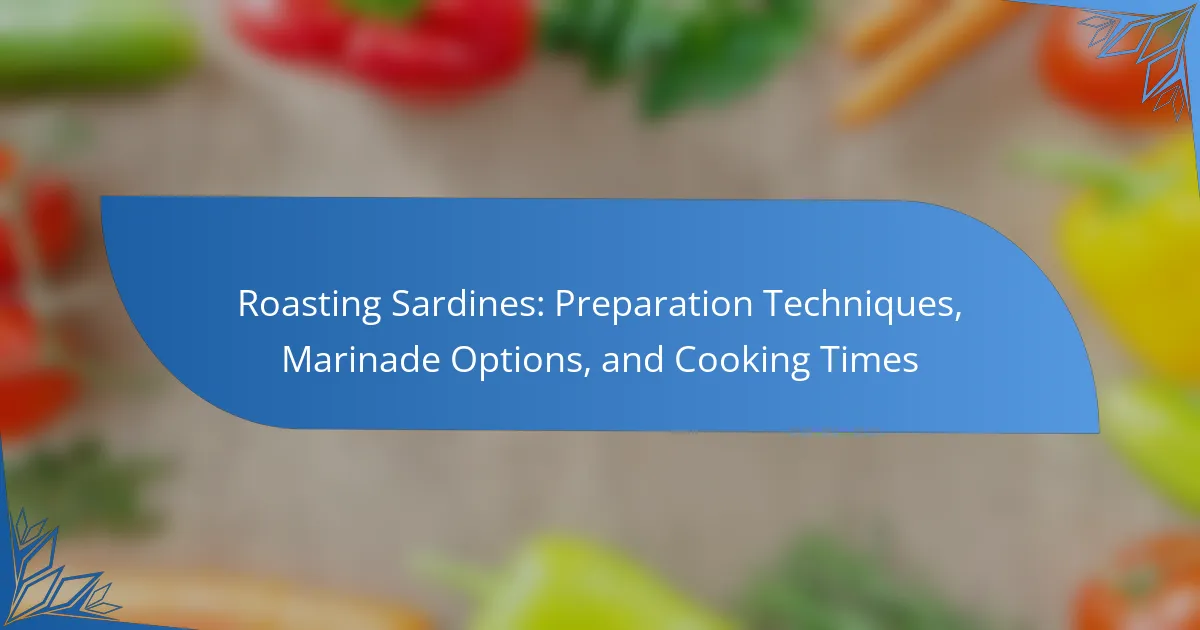
What are the essential techniques for roasting sardines?
The essential techniques for roasting sardines include proper preparation, seasoning, and cooking methods. First, clean the sardines by removing the scales and entrails. Rinse them under cold water and pat them dry. Next, season the sardines with salt, pepper, and optional herbs or spices. Common choices include garlic, parsley, or lemon zest.
Preheat the grill or oven to a high temperature, around 400°F to 450°F. Place the sardines directly on the grill or on a baking sheet lined with parchment paper. Roast for about 6 to 8 minutes, turning once halfway through. The sardines are done when they are opaque and the skin is crispy.
Using a high heat ensures that the sardines cook quickly, preserving their moisture. This technique is essential for achieving a flavorful and tender result.
How do you prepare sardines for roasting?
To prepare sardines for roasting, start by cleaning them. Rinse the sardines under cold water. Remove the scales using a knife or your fingers. Cut off the heads and gut the fish if necessary. Pat the sardines dry with paper towels. Season them with salt, pepper, and any desired herbs or spices. Drizzle olive oil over the sardines for added flavor. Preheat the oven to 400°F (200°C). Place the sardines on a baking sheet lined with parchment paper. Roast for about 10-15 minutes until they are cooked through and slightly crispy.
What tools and equipment are needed for roasting sardines?
To roast sardines, essential tools and equipment include a grill or oven, a fish spatula, and a heat-resistant tray. A grill allows for direct heat, which enhances flavor. An oven provides consistent cooking temperatures. A fish spatula helps in flipping sardines without breaking them. A heat-resistant tray catches drippings and prevents mess. Additionally, using skewers can aid in easy handling. These tools ensure effective cooking and easy serving of sardines.
What are the steps to clean and gut sardines?
To clean and gut sardines, start by rinsing them under cold water. Hold the sardine by the head and gently pull off the scales using your fingers or a knife. Next, insert your finger or a knife into the belly near the tail. Carefully slice open the belly from tail to head. Remove the innards and any dark membranes inside. Rinse the sardine again under cold water to remove any remaining debris. Finally, pat the sardines dry with a paper towel before cooking. These steps ensure the sardines are clean and ready for roasting.
What are the various roasting methods for sardines?
The various roasting methods for sardines include grilling, broiling, and oven roasting. Grilling sardines involves cooking them over direct heat, often on a barbecue. Broiling sardines uses high heat from above, typically in an oven. Oven roasting sardines allows for a more controlled cooking environment, often at moderate temperatures. Each method can enhance the flavor and texture of sardines. Grilling typically imparts a smoky flavor, while broiling can create a crispy exterior. Oven roasting allows for even cooking and can be paired with marinades for added flavor.
How does grilling differ from baking sardines?
Grilling sardines involves cooking them over direct heat, which imparts a smoky flavor. Baking sardines, on the other hand, uses indirect heat in an oven, resulting in a more even cooking process. Grilling typically requires less time, often around 5 to 10 minutes, while baking can take 15 to 20 minutes depending on the temperature. The texture of grilled sardines tends to be crispier due to the high heat, whereas baked sardines may be more tender and moist. Additionally, grilling often requires a marinade or oil to prevent sticking, while baking may not. The choice between grilling and baking can depend on desired flavor and texture outcomes.
What is the best way to roast sardines on a barbecue?
The best way to roast sardines on a barbecue is to prepare them simply with minimal seasoning. Start by cleaning the sardines and removing their entrails. Rinse them under cold water and pat them dry. Next, lightly coat the sardines with olive oil and season with salt and pepper. Preheat the barbecue to medium-high heat. Place the sardines directly on the grill grates, cooking for about 3-4 minutes on each side. The sardines are done when their skin is crispy and the flesh is opaque. This method retains the fish’s natural flavor and ensures even cooking.

What marinade options enhance the flavor of roasted sardines?
Marinade options that enhance the flavor of roasted sardines include lemon juice, olive oil, garlic, and herbs. Lemon juice adds acidity, brightening the fish’s natural flavors. Olive oil provides richness and moisture during roasting. Garlic contributes a robust aroma and depth to the dish. Fresh herbs like parsley and thyme offer aromatic notes that complement sardines. Marinades can also include spices such as paprika or chili flakes for added heat. These ingredients create a balanced flavor profile, making roasted sardines more appealing.
What are the most popular marinades for sardines?
The most popular marinades for sardines include olive oil, lemon juice, garlic, and herbs. These ingredients enhance the flavor of sardines significantly. A common marinade combines olive oil with fresh lemon juice and minced garlic. This mixture tenderizes the fish and adds a zesty taste. Another popular option is a marinade featuring soy sauce and ginger, which provides an Asian twist. Some recipes also incorporate vinegar and mustard for a tangy profile. Marinades typically allow sardines to soak for at least 30 minutes before cooking. This soaking helps infuse the flavors deeply into the fish. Overall, these marinades are favored for their ability to complement the natural taste of sardines.
How do citrus-based marinades affect the taste of sardines?
Citrus-based marinades enhance the taste of sardines by adding acidity and brightness. The citric acid in citrus fruits tenderizes the fish, making it more palatable. This acidity balances the natural oils in sardines, reducing any overly fishy flavors. Additionally, citrus flavors, such as lemon or lime, complement the rich taste of sardines. Research indicates that marinades can improve flavor absorption in fish. The result is a more flavorful and aromatic dish.
What herbs and spices can be used in sardine marinades?
Common herbs and spices for sardine marinades include garlic, parsley, and black pepper. Garlic adds a robust flavor that complements the fish. Parsley provides freshness and a hint of color. Black pepper enhances the overall taste with its mild heat. Other options are oregano, thyme, and chili flakes. Oregano and thyme offer earthy notes, while chili flakes can introduce spiciness. Lemon zest is also popular for its citrusy brightness. These ingredients work well with sardines, creating a flavorful marinade.
How do you create a balanced marinade for sardines?
To create a balanced marinade for sardines, combine equal parts of acidic, sweet, and salty components. Use ingredients like lemon juice or vinegar for acidity. Add honey or brown sugar for sweetness. Incorporate soy sauce or salt for the salty element. Ensure the total volume of marinade is sufficient to cover the sardines. A typical ratio is one part acid, one part sweet, and two parts salty. This balance enhances the flavor of the sardines without overpowering them. Marinades should be allowed to sit for at least 30 minutes to effectively penetrate the fish.
What ingredients should be included for a savory marinade?
A savory marinade should include olive oil, soy sauce, garlic, and herbs. Olive oil adds richness and moisture. Soy sauce provides umami flavor and saltiness. Garlic infuses a robust aroma and taste. Fresh herbs like rosemary or thyme enhance the overall profile. Lemon juice can also be added for acidity. These ingredients work together to tenderize and flavor the sardines effectively.
How long should sardines marinate before roasting?
Sardines should marinate for at least 30 minutes before roasting. This duration allows the flavors to penetrate the fish effectively. Marinating for longer, up to 2 hours, can enhance the taste further. The acid in the marinade helps to tenderize the sardines. A shorter marination time may not yield the same depth of flavor. Many recipes recommend this timeframe for optimal results.

What are the ideal cooking times for roasted sardines?
The ideal cooking time for roasted sardines is approximately 8 to 10 minutes. This duration allows the sardines to cook evenly while retaining their moisture. Sardines should be placed under a broiler or on a hot grill. Cooking them at high heat ensures a crispy exterior. It’s important to check for doneness by observing the flesh. The flesh should be opaque and easily flake with a fork. Overcooking can lead to dryness. Cooking times may vary slightly based on the size of the sardines. Larger sardines may require an additional minute or two.
How long does it take to roast sardines using different methods?
Roasting sardines takes different times depending on the method used. In a conventional oven, sardines typically roast for about 10 to 15 minutes at 400°F (200°C). When using a grill, sardines usually take around 5 to 7 minutes, turning once for even cooking. If employing a broiler, the roasting time is approximately 5 to 10 minutes, with close monitoring to prevent burning. Each method requires checking for doneness, indicated by the fish flaking easily with a fork.
What factors influence the cooking time for sardines?
The cooking time for sardines is influenced by several factors. The size of the sardines affects how quickly they cook. Smaller sardines typically require less time than larger ones. The cooking method also plays a crucial role. Grilling sardines usually cooks them faster than baking or frying.
The temperature used during cooking impacts the time as well. Higher temperatures will reduce cooking time, while lower temperatures will extend it. Additionally, whether the sardines are cooked whole or filleted can influence the duration. Whole sardines may take longer to cook through compared to filleted ones.
The freshness of the sardines can also play a part. Fresher sardines may cook more evenly and quickly due to their moisture content. Lastly, the thickness of the sardines affects cooking time. Thicker sardines will require longer cooking periods to ensure they are fully cooked.
How can you tell when sardines are properly cooked?
Sardines are properly cooked when they are opaque and flake easily with a fork. The internal temperature should reach 145°F (63°C). Cooking time typically ranges from 5 to 10 minutes, depending on the method. When cooked, sardines will have a slightly crispy exterior. The flesh should be moist, not dry. Proper cooking also eliminates any fishy odor. These indicators ensure that sardines are safe to eat and have optimal flavor.
What tips can improve the roasting process for sardines?
To improve the roasting process for sardines, ensure they are fresh and properly cleaned. Fresh sardines have better flavor and texture. Clean them by removing the guts and rinsing under cold water. Marinating sardines enhances their taste. Use a mixture of olive oil, lemon juice, garlic, and herbs for a flavorful marinade. Let them marinate for at least 30 minutes before roasting. Preheat the oven to a high temperature, around 400°F to 450°F, to achieve a crispy skin. Place sardines on a baking sheet lined with parchment paper to prevent sticking. Roast for about 10 to 15 minutes, depending on size, until the skin is crispy and the flesh is opaque. Flip them halfway through for even cooking. Use a meat thermometer to check for doneness; the internal temperature should reach 145°F.
How can you prevent sardines from drying out during roasting?
To prevent sardines from drying out during roasting, ensure they are properly marinated. A marinade with oil, lemon juice, and herbs helps retain moisture. Additionally, roasting sardines at a moderate temperature prevents overcooking. The ideal roasting time is approximately 8-10 minutes. This duration allows the fish to cook through while maintaining its juiciness. Using a baking sheet lined with parchment paper also aids in moisture retention. These techniques collectively enhance the flavor and texture of roasted sardines.
What are common mistakes to avoid when roasting sardines?
Common mistakes to avoid when roasting sardines include not cleaning them properly. Sardines should be rinsed and scaled before cooking. Another mistake is overcrowding the roasting pan. This leads to uneven cooking and steaming instead of roasting. Additionally, using too high of a temperature can cause the fish to burn. A moderate heat allows for even cooking. Failing to season adequately is also a common error. Sardines benefit from salt and herbs to enhance their flavor. Lastly, not monitoring cooking time can result in overcooked or undercooked fish. Sardines typically require only a few minutes to roast.
Roasting sardines involves essential techniques that include proper preparation, seasoning, and cooking methods. Key steps include cleaning and gutting the fish, applying marinades for enhanced flavor, and selecting appropriate roasting methods such as grilling or baking. The article details various marinade options, ideal cooking times, and tips to prevent drying out during roasting, ensuring a flavorful and tender result. Additionally, it outlines common mistakes to avoid for optimal cooking outcomes.


